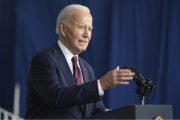
U.S. Customs and Border Protection (CBP) — the law-enforcement agency created as a division of the Department of Homeland Security in 2003 — flew nearly 700 surveillance missions on behalf of other federal, as well as state and local, law-enforcement agencies from 2010 to 2012. These figures came from flight logs released recently in response to a Freedom of Information Act (FOIA) lawsuit filed by the Electronic Frontier Foundation (EFF), a civil-liberties group.
In an update posted on its website on January 14, EFF noted that Customs and Border Protection recently released data from its flight logs indicating that it had flown 200 more surveillance missions for other agencies than previously reported. EFF reported the lower figures last July based on daily flight log records that CBP made available to the rights group in response to EFF’s FOIA lawsuit. According to those figures, CBP had an eight-fold increase in such surveillance flights.
Among the federal, state, and local law-enforcement agencies “borrowing” CBP’s drones were the FBI, ICE, the U.S. Marshals, the Coast Guard, the Minnesota Bureau of Criminal Investigation, the North Dakota Bureau of Criminal Investigation, the North Dakota Army National Guard, and the Texas Department of Public Safety.
Customs and Border Protection initially said that the information released last July represented all the missions the agency flew on behalf of other law-enforcement agencies. However, in a notice of cross motion for summary judgment filed against CBP by EFF attorney Jennifer Lynch on December 11, 2013, EFF asked the court to “issue an order requiring the government to release all records improperly withheld from the public.” Just prior to the court hearing on EFF’s motions, CBP announced that it had “discovered that it did not release all entries from the daily reports for 2010-2012.”
The new information revealed that CBP’s surveillance activities for other agencies were more extensive than previously reported. As EFF notes: “Not only do these new flight logs and the accompanying new list of agencies show a striking increase in the overall number of flights (700 versus 500) they also reveal a sharp increase in the number of flights for certain federal agencies like ICE (53 more flights than previously revealed) and the Drug Enforcement Agency (20 more flights).”
Furthermore, wrote EFF, “CBP continues to withhold the names of many of these state and local agencies, arguing that revealing them would somehow impede ongoing investigations.” The EFF report pointed out the lack of validity of this argument, noting that merely providing the names of law-enforcement agencies using CBP’s drones would not be specific enough information to affect any particular criminal operation.
Significantly, EFF summarized the problematic privacy violations inherent in CBP’s expanded role: “As the use of Predators [drones] moves from maintaining security at the nation’s borders to general law enforcement elsewhere within the country, more and more people in the United States will be subject to drone surveillance.”
The EFF report also noted that as the drones’ equipment becomes more sophisticated, they will be able to utilize facial recognition software to identify individuals from aloft.
The story of EFF’s battle to expose Customs and Border Protection’s extra-agency surveillance operations was picked up by the Russian RT network, which reported:
The data obtained by EEF showed that the name of the government agency borrowing the drones was heavily redacted, but CBP officials provided their own separate tally of the various agencies employing its drones.
Civil rights advocates, however, fear the implications on individual privacy as the government pushes for greater drone use in American skies.
RT noted that, because of safety concerns, CBP is the only agency (aside from the military) authorized by the Federal Aviation Administration (FAA) to operate unmanned aerial vehicles regularly inside the United States.
Consequently, other law-enforcement agencies that lack their own drone fleets are increasingly asking CBP to carry out missions on their behalf.
RT also noted that the Defense Department is prohibited from using its drones within the United States for law-enforcement activities.
RT observed that due to the powerful spying capabilities of the drones’ technology, “civil rights groups are concerned the drones will lead to the rise of a surveillance state of sorts, with American privacy being invaded at every corner.”
The irony of RT’s report about the U.S. government’s spying on its own citizens is apparent. Though RT is registered as an autonomous nonprofit corporation, it is funded by the Federal Agency on Press and Mass Communications of the Russian Federation, an agency under the authority of the Ministry of Communications and Mass Media, the successor organization to the Soviet Union’s Ministry of Communications. Nikolai Nikiforov, Russia’s minister of communications and mass media, was named to serve in former President and current Prime Minister Dmitry Medvedev’s cabinet. Medvedev was a member of the old Soviet Communist Party prior to 1991.
In 2008, Medvedev appointed Vladimir Putin as prime minister, and in 2012 Putin was elected to the presidency, succeeding Medvedev. Like Medvedev, Putin was a member of the Communist Party of the Soviet Union and had a long career with the KGB, the Soviet Union’s notorious spy agency.
That a Russian news agency that answers ultimately to two high-ranking former communist officials — one a veteran of the KGB — is reporting that the U.S. government is engaging in intrusive spying on it own citizens is nothing if not fraught with irony.
In his article for The New American last October 3, Joe Wolverton reported that among the new agencies found borrowing CBP drones were: “Grand Forks SWAT, the North Dakota Narcotics Task Force, the Bureau of Indian Affairs, the Arizona Department of Public Safety, the Minnesota Drug Task Force, and several branches of the military.”
That last item, noted Wolverton, raised an immediate red flag.
“For what lawful purpose could the armed forces be conducting such operations domestically?” asked Wolverton. “Furthermore, the likelihood is high that such activities run afoul of the Posse Comitatus Act, which prohibits the U.S. military from performing domestic law-enforcement duties.”
The use of surveillance drones by numerous law-enforcement agencies raises the concerns of civil libertarians that the Fourth Amendment (which states, in part, “The right of the people to be secure in their persons, houses, papers, and effects, against unreasonable searches and seizures, shall not be violated”) has been consistently disregarded since the terrorist attacks of 9/11 prompted the creation of a new intrusive governmental department in Homeland Security — with its sub-agencies, such as U.S. Customs and Border Protection. (The old U.S. Customs agency was part of the Treasury Department, and its primary goal was to collect import duties and to prevent smuggling to evade such duties.)
We can be thankful that watchdog groups such as the Electronic Frontier Foundation are vigilantly keeping an eye on our government’s proliferating spy activities.
Related articles:
Domestic Drone Launch Date Approaches; Drones to Be Autonomous
What States Are the Drones Watching?
U.S. Drones Kill More Than 30 in Yemen; School Targeted in One Attack
Border Patrol Loaning Predator Drones to Military, State, and Local Police
Pakistani Military Unveils Its Own Drones
Military and Police Drones Exempted From New Texas Drone Law
Rand Paul Opposes New FBI Director, and FBI’s U.S. Surveillance Drones



